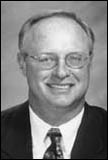President's message
Educational reform or just keeping up with the times?
 The discussion about veterinary edu-cation is livelier than ever. Nearly every day now, I am talking to someone about what changes are
being considered for veterinary education and especially for the food supply
veterinarian. The Food Animal Summit Task Force (FAST) Committee continues to push
forward on a study to assess future needs and action items. These identified action
items are listed below:
The discussion about veterinary edu-cation is livelier than ever. Nearly every day now, I am talking to someone about what changes are
being considered for veterinary education and especially for the food supply
veterinarian. The Food Animal Summit Task Force (FAST) Committee continues to push
forward on a study to assess future needs and action items. These identified action
items are listed below:
- Identify and evaluate existing and emerging factors (eg, economic, societal) affecting the applicant pool of students attracted to food supply veterinary medicine (FSVM).
- Determine how to recruit students and develop and maintain students' interest in FSVM while in veterinary school.
- Determine factors that affect selection of employment by FSVM graduates.
- Determine how to retain recent graduates in FSVM for more than 5 years.
Several groups are involved with FAST. The AABP (American Association of Bovine Practitioners), AASRP (American Association of Small Ruminant Practitioners), AAVMC (Association of American Veterinary Medical Colleges), and AVC (Academy of Veterinary Consultants) are most involved in the process. Our Canadian neighbors are facing the same questions, and the above organizations with Canadian members are actively engaged in FAST as well. It seems that all food supply and food animal disciplines are clamoring for action.
The dilemma facing veterinary curriculums is the growing divergence between the educational needs of companion and food supply animal veterinarians. The fastest growing newly offered course and degree studies are in public health. Several universities are now offering a Master of Public Health (MPH) degree in conjunction with a DVM. Nearly all listings for federal veterinary positions suggest that veterinarians with an MPH degree are most employable. The veterinary disciplines taught in these programs are not completely congruent with traditional individual animal veterinary medicine.
The companion animal (and probably equine) sectors are going very well, both in attracting students and delivering a quality education. Society equates veterinarians almost exclusively today with medical care of pets and horses. It is only natural for our institutions of higher learning to focus on continuing this success. Resources are becoming a constant problem; for example, the state of Nebraska recently dropped its financial support for veterinary students. Our veterinary institutions face priority decisions about programs. The food animal (or food supply) veterinarian is in the extreme minority, and most of the compromises in resources and educational delivery will be in this sector of veterinary medicine.
Dr Lonnie King, in a powerful Howard Dunne lecture, gave us these thoughts about the future of Food Animal Veterinary Medicine:
"In my opinion, there are five (5) [Strategic Inflection Points] that have and are fundamentally changing our food animal and swine industries and help define your volatile environment. These are: (1) a shift from local and national markets that were commodity focused to a global market that is much more value-added and niche market-focused; (2) a shift from an emphasis on production increases to a new emphasis on the social acceptance of pork products and their production; (3) a shift from a privileged class status to an industry that the public holds in less esteem and believes is responsible for a number of societal problems; (4) a shift from envisioning food as sustenance to food as a health promoter; and (5) a shift from an emphasis on animal health to an emphasis on public health. Worldwide changes are transforming American agriculture into an endeavor focused not only on efficient food and fiber production, but also on delivering improved public health, social well-being, and a sound environment."1
His thoughts here are absolutely on target and are a reminder that we must recognize the need to move forward, properly managing these changes.
The AASV organization and its elected representatives are working daily to move ahead on changing veterinary education to fully complement the strong historical teaching methods with innovative methods to deliver new food supply veterinary education. Dr Sandy Amass is coordinating "The First Annual Purdue University Swine Educator Conference" to be held on May 20 and 21, 2003. This conference is further evidence of the awakening by the profession to the fact that veterinary education is at a crossroads.
Stay tuned for further developments around this issue. If you haven't been involved in your veterinary school recently, GET INVOLVED! The only way a minority is heard is through an active voice. If you have ideas that your AASV leadership needs to hear, please pick up the phone and call.
It is raining again today in central Iowa - that makes about 5 inches in the last week. I believe the drought is over!
May this message find you well and having enjoyable work every day.
Reference - non refereed
1. King, LJ. As the future catches you (Howard Dunne Memorial Lecture). Proc AASV. Orlando, Florida. 2003:9-21.
--Rick Sibbel
